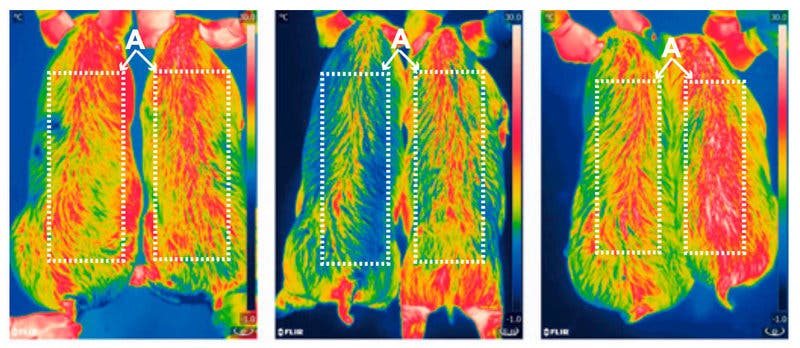Scientists have developed a new genetic technique that allows pigs to regulate temperature by burning fat.

Zheng et al. / PNAS.
CRISPR bacon
Eating less meat — especially red meat — is important not only from a health point of view, but also from an environmental perspective. But not everyone cares about that. The meat industry is still growing at a dazzling rate and worldwide; there are around 1 billion pigs in the world, and not many of them are grown as pets — so it’s easy to understand why there is so much incentive for research.
Researchers at the Chinese Academy of Sciences in Beijing were looking at ways through which they could genetically edit pigs and make them more resilient to cold. This could not only save growers a lot of money in heating costs, but it could also prevent unnecessary suffering. Every year, millions and millions of piglets suffer or die due to cold. This way, they can survive the cold easier, and die a bit later.
The animals were created using a new gene-editing technique known as CRISPR-Cas9 (or simply CRISPR). As a result of their work, 12 pigs ended up with 24% less fat on average,
“This is a big issue for the pig industry,” says Jianguo Zhao of the Institute of Zoology at the Chinese Academy of Sciences in Beijing, who led the research. “It’s pretty exciting.”
Unlike most mammals, pigs don’t have a gene called UCP1 — also called Thermogenin. Thermogenin is used to generate heat without shivering, allowing animals to regulate their temperature in cold environments. Researchers applied CRISPR to edit a variation of this gene into pig cells. They then used those cells to create more than 2,553 cloned pig embryos. These genetically modified pig embryos were then implanted into 13 female pigs. Just three of them became pregnant, but these three produced 12 male piglets, the researchers report. These piglets had the UCP1 gene, were able to regulate their temperature, and as a result, had much lower quantities of fat.

However, it’s still not clear if the FDA and other regulatory administrations would allow growers to incorporate this technique. It’s also not clear if people are willing to eat such genetically modified pigs. But with the planet’s constantly growing population, we might need all the help we can get.
“The population of our planet is predicted to reach about 10 billion by 2050, and we need to use modern genetic approaches to help us increase the food supply to feed that growing population,” says Chris Davies, an associate professor in the school of veterinary medicine at Utah State University in Logan, Utah, who was not involved in the study.
However, if anything, the study is a testament to how much genetic editing has advanced. The potential of CRISPR is immense, allowing researchers to edit genes with unparalleled precision. So far, it’s been already used to create animal models, control infection of bacteria and viruses, and correct defective genes.
Additionally, while researchers don’t really stress this point, a similar approach could, eventually, be applied directly to humans to allow us to increase or decrease fat content. The world is struggling with an obesity pandemic, with over 2 billion people overweight or obese.
Journal Reference: Qiantao Zheng et al. Reconstitution of UCP1 using CRISPR/Cas9 in the white adipose tissue of pigs decreases fat deposition and improves thermogenic capacity. doi: 10.1073/pnas.1707853114


